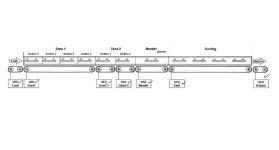Hello everyone,
I am currently working on re-writing the PLC programming from scratch for a glass tempering machine. I used to do mostly process automation programming. Therefore, this project is definitely something new for me.
Please see attached picture for the layout of the glass tempering system. From what I had learnt so far, the programming can be divided into two sections: furnace heating control and conveyors movement control. I want to focus on conveyors movement section first. As you can see in the picture, the system consisted of 6 parts: loading conveyor, furnace zone 1, furnace zone 2, bender zone, cooling conveyor and unloading conveyor. Each conveyor will be controlled by a VFD and an incremental encoder feedback to a high speed counter card.
The process starts with glass being loaded at the loading conveyor and is driven forward towards the furnace until the limit switch (which is installed at the end of loading conveyor) detects the front of the glass. When furnace is ready to accept new glass, the glass will be driven from loading conveyor into the furnace. The glass starts to automatically oscillate inside the furnace. Glass oscillates in section 1 for certain period and then moving towards section 2. When zone 1 conveyor move glass from section 1 to section 2, a new glass will loaded into section 1 from the loading conveyor and start the oscillating process again.
My first question is whether using VFD and encoder are the right implementation to control the conveyor in this oscillating process (back and forward movement)?
My second question is how to use the VFD and encoder to accurately move the conveyor forward and reverse at specified distance? My thought is that if I want the conveyor to move forward 10 inches exactly, the VFD ramp down time should be taken into consideration. So the VFD stop command is issued in advance before the encoder counter reaches the targeted count. Therefore I need to calculate when to issue the stop command.
To simplify the calculation, let assume encoder PPR=500; conveyor drive sprocket diameter= 5 in.
I can determine conveyor travel per revolution by multiplying 5 * 3.14 (pi) = 15.7
Then I calculate pulses per inch (PPI) by dividing 500 / 15.7 = 31.85 PPI.
If I can calculate the conveyor velocity (pulses per second) and knowing the VFD ramp down time, I should be able to find out the exact moment to issue the VFD stop command so that the conveyor will travel and stop at the expected position.
I am not sure my thought process is on the right path. Does anyone familiar with this type of conveyor movement control? mind to share with me?
Greatly appreciate any input/feedback.

I am currently working on re-writing the PLC programming from scratch for a glass tempering machine. I used to do mostly process automation programming. Therefore, this project is definitely something new for me.
Please see attached picture for the layout of the glass tempering system. From what I had learnt so far, the programming can be divided into two sections: furnace heating control and conveyors movement control. I want to focus on conveyors movement section first. As you can see in the picture, the system consisted of 6 parts: loading conveyor, furnace zone 1, furnace zone 2, bender zone, cooling conveyor and unloading conveyor. Each conveyor will be controlled by a VFD and an incremental encoder feedback to a high speed counter card.
The process starts with glass being loaded at the loading conveyor and is driven forward towards the furnace until the limit switch (which is installed at the end of loading conveyor) detects the front of the glass. When furnace is ready to accept new glass, the glass will be driven from loading conveyor into the furnace. The glass starts to automatically oscillate inside the furnace. Glass oscillates in section 1 for certain period and then moving towards section 2. When zone 1 conveyor move glass from section 1 to section 2, a new glass will loaded into section 1 from the loading conveyor and start the oscillating process again.
My first question is whether using VFD and encoder are the right implementation to control the conveyor in this oscillating process (back and forward movement)?
My second question is how to use the VFD and encoder to accurately move the conveyor forward and reverse at specified distance? My thought is that if I want the conveyor to move forward 10 inches exactly, the VFD ramp down time should be taken into consideration. So the VFD stop command is issued in advance before the encoder counter reaches the targeted count. Therefore I need to calculate when to issue the stop command.
To simplify the calculation, let assume encoder PPR=500; conveyor drive sprocket diameter= 5 in.
I can determine conveyor travel per revolution by multiplying 5 * 3.14 (pi) = 15.7
Then I calculate pulses per inch (PPI) by dividing 500 / 15.7 = 31.85 PPI.
If I can calculate the conveyor velocity (pulses per second) and knowing the VFD ramp down time, I should be able to find out the exact moment to issue the VFD stop command so that the conveyor will travel and stop at the expected position.
I am not sure my thought process is on the right path. Does anyone familiar with this type of conveyor movement control? mind to share with me?
Greatly appreciate any input/feedback.





